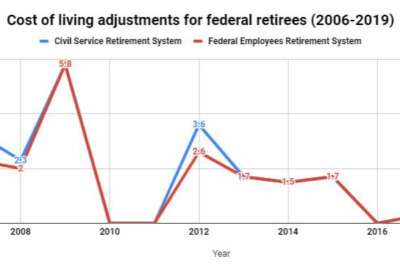

For the last six years many federal workers and retirees have had nightmares about losing major parts of their Civil Service Retirement System and Federal Employees...
Each year there have been efforts to either make feds pay more for their pensions or to drastically reduce the value of their lifetime annuities. Some of the years politicians merely went through the motions. In others they just missed making drastic permanent cuts to the retirement programs. And the bogeyman hiding under the bed or in the closet is very real, usually in the form of the White House and/or Congress — sometimes both.
During the Obama years new hires under FERS were required to contribute more of their paycheck toward their retirement plan.
Each year Congress has revisited and reviewed a group of proposals that would trim billions of dollars in retiree benefits over a 10-year period. The proposed changes include:
Ironically, that would hit hard one of the few groups of organized federal workers that endorsed Donald Trump for the presidency: Border Patrol. Each time the president visits the border to promote the wall, he usually does a photo op with those union members and their leaders.
In addition to the proposed retirement plan changes, the White House is moving ahead on its 2018 plan to eliminate the Office of Personnel Management. If approved many functions, such as retirement, would be shifted to the General Services Administration. Background checks would go to the Pentagon and personnel policy matters would be taken over by the White House Office of Management and Budget.
So what would work life be like if feds lose the only agency devoted exclusively to them? And what are the odds that some of those chilling retirement cuts will become law?
We’ll find out today on our Your Turn radio show at 10 a.m. EDT. My guest will be Federal News Network’s Nicole Ogrysko who covers workforce issues on the Hill. She’ll outline the changes feds and retirees may be facing and talk about what the Democratic take-over of the House might mean for plans to curtail your retirement benefits. Listen at www.federalnewsnetwork.com or 1500 AM in the Washington, D.C. area.
By Amelia Brust
The California roll was invented in Vancouver by Japanese-Canadian chef Hidekazu Tojo in 1971. He hid the seaweed inside the roll to be more appealing to Canadian and American customers, and he named it the “California” roll because it was especially popular with diners from Los Angeles.
Source: The Globe and Mail
Copyright © 2025 Federal News Network. All rights reserved. This website is not intended for users located within the European Economic Area.
Mike Causey is senior correspondent for Federal News Network and writes his daily Federal Report column on federal employees’ pay, benefits and retirement.
Follow @mcauseyWFED

